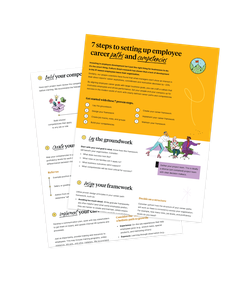
Article

Written by

Writer, Culture Amp

Senior Content Marketing Manager, Culture Amp
Considering the state of the world over the past couple of years, it’d be easy to assume that job satisfaction is fairly low right now. Surprisingly, the opposite is true – it’s actually the highest it’s been in 20 years, according to data from The Conference Board. That said, only 62.3% of US employees say they’re very satisfied with their job, a number that could be much higher.
According to that same data, one of the most consistent contributors to employee satisfaction over the last 10 years has been the potential for future growth. Likewise, Culture Amp data has also found that employees who don’t have access to meaningful L&D opportunities are two times more likely to leave an organization within a year.
With that said, what can leaders do to help paint a motivating picture for employees in their organization? Well, we’ve found that career pathing is a powerful place to start.
Career pathing (similar to career mapping) is defined as the series of jobs an individual intends to hold during their time at a company (or over their career as a whole). It’s more than just a list of jobs, though – think of it as a roadmap.
The starting point is the employee’s current position, while the destination represents a goal, either short- or long-term. The career path encompasses the entire route, along with all the twists, turns, and pit stops that the employee needs to take to get to the “finish line.”
A career path is as unique as the employee that follows it. While it’s helpful to have a basic path mapped out that reflects how a new hire might advance into a management role, that isn’t going to be anywhere near as helpful as a personalized career path explicitly developed with the employee’s history, skills, knowledge, and experience in mind.
Finally, not every career path will be vertical — in other words, not everyone wants to move up the corporate ladder. A horizontal career path, while not as common, maps out the options for employees who wish to move to a different department or role without fundamentally changing what they do or the nature of their responsibilities.
For example, a software developer might not be interested in a management position. If they would instead remain an individual contributor, the next step in their career could involve owning more complex and cross-functional software projects.
Career mapping and career pathing are very closely related concepts. While a career path represents one career “road,” a career map identifies and outlines various career paths an employee can take. In other words, you can think of a career map as depicting the broader landscape of career paths.
In this article, we focus primarily on career pathing, but many of the benefits we explore and tips we provide are also applicable to career mapping.
Below, we explore how developing career paths can drive essential business benefits and outcomes.
Employee development directly impacts employees’ feelings about their company – and, thus, their intent to stay at a company. Research from IBM found that employees are hungry for career advancement opportunities, ranking ahead of other factors like compensation and organizational stability. Providing clear career paths for staff is an excellent way for businesses of all sizes to avoid turnover and retain their top talent. While the Great Resignation is no longer in full swing and labor markets have become tighter, we know that people will still consider leaving an organization if it no longer aligns with their values and aspirations.
Companies would do well to mitigate turnover, as it’s exceptionally expensive, costing US businesses a trillion dollars each year. Replacing an employee not only costs money but also requires a time investment and could potentially even damage the team's morale. Conversely, engaged and satisfied employees contribute to a more productive and profitable company.
Career pathing enables employees to grow alongside the company. Everyone benefits from effective career pathing. In creating this roadmap, employees gain clarity on what steps they can take to further their careers, along with the training and development opportunities to make it happen. And employers experience more engaged staff and a clearer idea of how to position the right people in the right places to foster growth. It’s a win-win.
Career pathing is an excellent plus for internal recruiting, which is considered one of the most effective ways to fill vacancies and strengthen your team for several reasons:
Tip: How to make the most of internal recruiting
To find candidates for promotion, start with management. Ensure that your company’s leadership has a list of available positions and their criteria handy when they’re reviewing team performance.
Having rough career paths sketched out for each position in your company will make it easier to spot internal recruiting opportunities as they arise. While these generic paths won’t necessarily map to each individual employee, they provide guidelines that can help you recognize when someone has the skills to succeed in a particular role.
By taking a proactive approach to internal recruiting, you not only get to approach employees and offer them exciting new positions but also move your company toward a better version of itself by ensuring the right team members are in the right positions.
Effective employee development through career pathing starts with management. An employee’s direct manager is most familiar with their strengths and weaknesses, as well as what it would take to advance their career. Their direct manager also knows the requirements, challenges, and opportunities of each position in their department.
To get started, managers can sit down with each member of their team to discuss their career goals and ask candid questions like:
Once the employee has a goal in mind, the manager can work with them to create a roadmap that gets them from their current position to that destination. This might include promotions to aim for and weaknesses to overcome. It should also include competencies, which refer to the behavior, knowledge, or skills an employee needs to have to succeed in their role. A roadmap that includes all these components will give both parties a clearer picture of where the employee is, where they’re headed, and how they’ll get there.
This roadmap should be documented and stored where it's easily accessible for the employee, manager, and HR team. Managers can encourage employee progress by checking in with them about the plan and their progress regularly – at least monthly – with a longer dedicated conversation during performance reviews.
Even after the plan is in place, there’s room for flexibility. A good leader is always on the lookout for potential opportunities – both horizontal and vertical – that could benefit either their direct reports or the larger organization. Identifying ways for employees to grow and thrive is one of the primary responsibilities of management, and it’s an important way managers can show their team that they want to see them succeed.
Finally, ensure that at every level of your company, the job descriptions are thorough and clear. You’re more likely to attract interest and find the right candidate when people understand the requirements and responsibilities of the position.
Tip: Support your managers
It’s not easy being a manager, and it’s crucial to provide your managers with tools and training to help them navigate their many roles and responsibilities. Check out these resources for ideas for empowering and supporting your managers: [1] [2] [3]
Whether you’re looking to round out your team with some internal promotions or strengthen employee engagement during times of change or uncertainty, career paths can help. This method of planning out the path to a specific position or promotion brings clarity to teams and individual employees. Moreover, it ensures that everyone is on the same page regarding where they’re at – and where they’re headed.
Career Paths, part of Develop by Culture Amp, is one tool that can help you drive growth and performance at scale through easy-to-make-and-manage career paths. With a customizable competency library, powerful competency frameworks, role descriptions, and role tracks – all accessible from a centralized development hub – Career Paths empowers your people to excel in their current roles and motivates them to grow with the company.
Learn more about how to create career paths in the Culture Amp platform.

Learn how to develop a motivating career framework, set up career paths, and define competencies – all in 7 proven steps.
This article was updated on 12/4/2023 with new information.